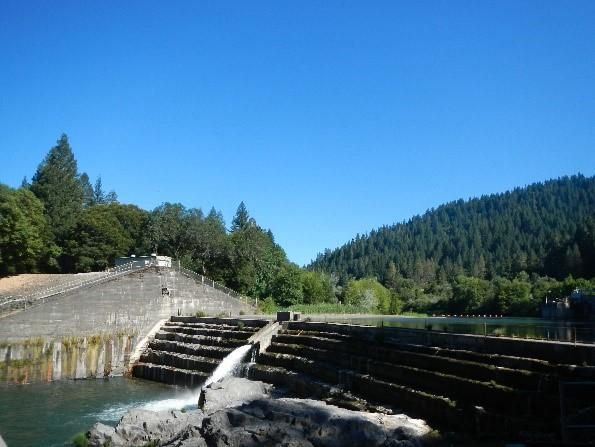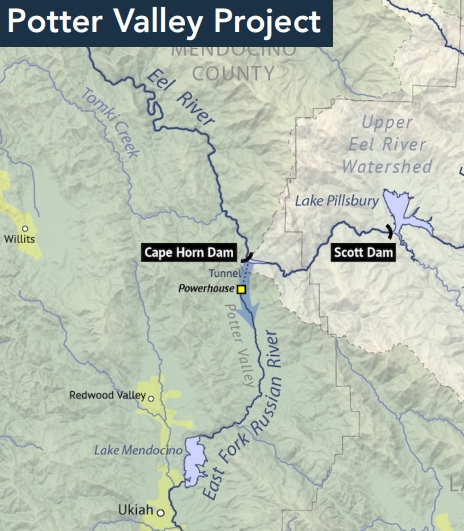
We’ve all been hearing some pretty scary things over the past few weeks about important land-stewardship projects across California losing their federal funding and support — national park and forest maintenance, wildfire prevention programs and more. But there’s one ongoing environmental initiative with big implications for Healdsburg’s water supply that it seems we can be cautiously optimistic about: the Potter Valley Project up in Humboldt County.
A whole host of different state agencies, county governments, tribes and other orgs reportedly reached a “historic pact” on the project’s future last week. Potter Valley is an old, defunct power plant with two dams that PG&E officials run along the Eel River — one they’ve been wanting to get rid of for years now. In fact, there are very few remaining fans of the Potter Valley Project. Local tribes especially would love to see the Eel River undammed, with dreams of a salmon revival and ecological renaissance like what we’re seeing along the newly dam-less Klamath River to the north.
The complication being, of course, that this same Potter Valley apparatus currently diverts Eel River waters into the Russian River — a lifeline for hundreds of thousands of people living in downstream communities like Healdsburg, who use this water to survive. Which brings us back to this new pact, signed in a ceremony last Thursday, Feb. 13. The Press Democrat reports:
Officials from three counties and the Round Valley Indian Tribes have reached a historic agreement that paves the way for continued diversions from the Eel River to bolster flows in the Russian River.
The agreement represents a critical development for anyone whose water comes from the Russian River.
The complex accord resulted from years of negotiations to preserve supplemental flows in the Russian River, the water lifeline for residents, ranchers and wildlife in Sonoma and Mendocino counties. The agreement also supports the restoration and fish recovery in the Eel River, which was crucial to securing support from environmental interests, tribes and Humboldt County residents.
It is, at last, the “two-basin solution” envisioned by regional stakeholders in 2019 and even earlier, when Pacific Gas & Electric first raised questions about whether to continue operating the small, aging hydroelectric plant in Potter Valley through which Eel River flows have been redirected.

But the path to sustainability isn’t over yet. It’ll be a long and expensive one, by the sound of things. To start, we’ll get less water now — around 12% less per year, according to the PD — because diversions to the Russian River will mostly only happen in rainy months, when Eel River waters are high enough to support it. Also: Under the agreement, Russian River water users are expected to ”wean themselves from the Eel River by developing new water storage and supply solutions” and “raise $50 million or more for new diversion facilities and $50 million or more for additional restoration funding.” In addition, we’ll need to pay around $1 million per year to the Round Valley Indian Tribes, who will now own Eel River water rights instead of PG&E, for continued diversions — and up to another $1 million per year for ongoing environmental restoration efforts.
As far as I know, it’s not yet clear where exactly this money will be coming from. (And I have no idea what’s going on with that $15 million in federal funds promised to the project by U.S. Congressman Jared Huffman last month; I’ve been asking his office about it, but last I heard from them, they were “still gathering information and updates so don’t have a solid read out right now.”) So, yeah — everything is not all figured out forever. The latest plan still has its critics, too, like folks in Lake County who rely on water from the Lake Pillsbury reservoir. (Pillsbury is currently fed by the Eel, and would go dry under this plan, as I understand it.)
Still, the big thing that many others are celebrating at this juncture is how many groups with opposing interests came together to compromise and agree on something, in an age of chronic division and discord. Here are some choice quotes from the pact-signing ceremony last week, via the PD:
While the paradigm for addressing contentious issues, especially water, is conflict and litigation, “you all chose a different way among a lot of different interests, different needs,” [California Natural Resources Secretary Wade Crowfoot] said. “This pathway is a model not only for California but for our country at this time.”
In a nod to recent rhetoric from President Donald Trump regarding California water policy, [California Fish & Wildlife Director Chuck Bonham] referenced critics who call the state “crazy,” incompetent and foolish for choosing “fish over water” supply.
“We can do ‘yes, and …’” Bonham said. “We can do it all in California.”
Another reason to celebrate is that, under this plan, we’d potentially be entering into more of a right relationship with an outside water source we seized as our own more than a century ago. No one is celebrating this aspect harder than Lynda Hopkins, chair of the Sonoma County Board of Supervisors. She couldn’t contain her excitement in a newsletter she sent to constituents a couple of days ago. I’ll reprint the whole thing here, even though it’s long, because it feels important. Take it away, Lynda:
It’s not every day that you get to take part in a historic moment. Last Thursday was one of those days where I had to pinch myself and ask, is this real life? Is this really my day job?
On Thursday February 13, an MOU was signed between the Round Valley Indian Tribe, Mendocino County Inland Power & Water Commission, County of Humboldt, Trout Unlimited, CalTrout, Sonoma Water, and the California Department of Fish & Wildlife. This couldn’t have happened without the leadership of Secretary Wade Crowfoot and California Department of Fish and Wildlife Director Chuck Bonham.
This MOU will support water security for Sonoma County. It will allow us to continue to provide more than 600,000 people in Marin and Sonoma Counties with drinking water. It will support agriculture in Mendocino and Sonoma Counties. In the lower Russian River, it will support maintaining our minimum instream flows which is critical for native fish and our summertime economy. This is a big deal for us here locally.
But much more importantly… this MOU will begin to right a wrong that started one hundred and twenty-five years ago.
Ground was broken on the Potter Valley Project in 1900. Think about that: 125 years of the Russian River Watershed taking, without asking, from the Eel River Watershed, all because some guy had the bright idea to punch a hole through a mountain. 125 years of impacts to Tribal culture, fisheries, riparian and estuarine ecosystems. 125 years of a transactional relationship that only went in one direction. The Eel River was treated like a bank that we only ever withdrew funds from.
Last week we committed to taking water only in high flows. This is known as the “run of the river” solution, and the “two basin” solution. And what’s more: we committed to compensating the People and the lands that have been harmed by this transfer for more than a century. The sovereignty of the Round Valley Indian Tribe is honored as the holders of the water rights. The Tribe will be receiving annual payments for as long as the water flows between the watersheds. Additional annual payments will go towards an Eel River Restoration fund.
In my 8 years in government I’ve never witnessed such diverse interests come together to make the world a better place. Tribal leadership. Local governments who were on opposite sides of a 125 year deal (with some of us benefitting, and some of us being harmed). Environmental groups. A state agency more accustomed to regulating than creating. We all stepped out of our comfort zones and did something today. Was it a compromise? Absolutely. Was it perfect? Absolutely not. We still have a long way to go — to honor our agreement, and to ultimately transition to a self-sufficient Russian River watershed.
But it felt like the arc of the universe bent a little bit more towards justice on that day. And it was an honor to be there and be part of it. We CAN change the world. It starts with respecting and honoring each other, and history.










